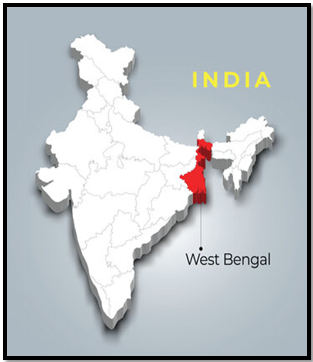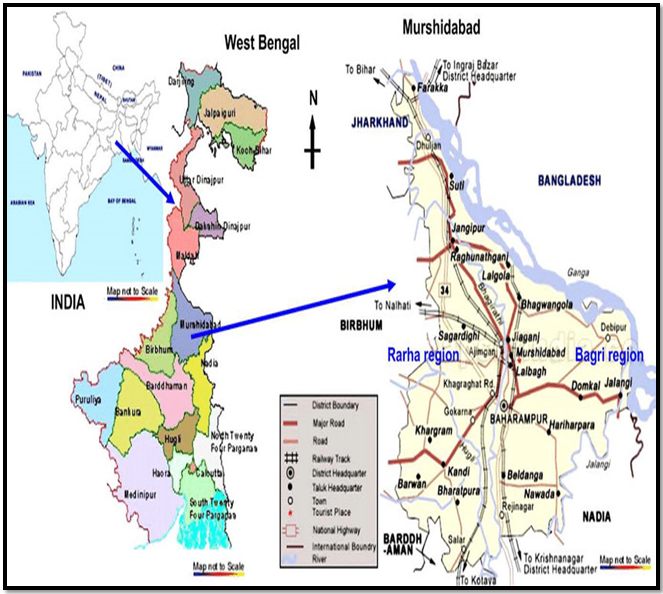DIVIDED BY BORDERS, RIVERS, AND POLARISING POLITICS
Relevance:
- GS 2 – International Relations, Border Security, and Politics
- GS 1 – Geography (Human Geography)
Focus
The article explores the complex social and geopolitical considerations that underlie Murshidabad, West Bengal’s proposal for a Union Territory. It examines the difficulties with border security, illegal immigration from Bangladesh, and the ensuing changes in the region’s population that have exacerbated political unrest.
Current Scenario
- Geopolitical Sensitivity: Murshidabad is a crucial district where the problem of illegal immigration has been made worse by the geographical difficulties in building walls along the riverine boundaries. The district has a porous border with Bangladesh.
- Political Tensions: Claims of demographic shifts have become a focal point for both the TMC and the BJP, intensifying polarization in the political scene and driving the demand for a Union Territory in Murshidabad.
- Changes in the Religious Demographics: Growing worries over the purportedly illegal immigration-related changes in the religious demographics of Murshidabad have escalated tensions, especially with the Muslim population’s rise fuelling hostilities with the Hindu minority.
Key Issues
- Border Security Challenges:
- Porous Borders: The border between Murshidabad and Bangladesh is more than 150 km long, and a large chunk of it is bisected by rivers like the Padma and Ganges, which makes it challenging to build physical barriers.
- Concerns about infiltration: Ministry of Home Affairs (MHA) reports show that thousands of undocumented immigrants enter Murshidabad annually, putting a burden on the region’s resources and security setup.
- Impact on Local Population: Since a result of the ongoing immigration wave, local complaints have gotten worse since there is more competition for jobs, land, and other resources.
- Political Polarisation:
- Union Territory Demand: The state government’s alleged neglect, according to some, is a contributing factor in the demand for Union Territory status for Murshidabad. The state administration is accused of failing to combat illegal immigration and safeguard the interests of the local populace.
- Election Strategy: The TMC has countered by highlighting secularism and minority rights, which has increased polarization, while the BJP has used the problem of illegal immigration to energize its support base.
- Impact on Voters: Taking advantage of the illegal immigration situation, the BJP gained a lot of ground in border districts like Murshidabad in the 2021 West Bengal Assembly elections.
- Demographic Concerns:
- Religious Make-Up: According to census data, Murshidabad’s Muslim population grew from 63% in 2001 to 66% in 2021, while the Hindu population saw a comparable dip.
- Effect on Social Cohesion: As a result of shifting demographics, there is apprehension among groups about possible intercommunal conflicts akin to those that occurred during the Partition.
- Long-term Implications: As a result of the ongoing demographic changes, the sociocultural makeup of the area may change, increasing community tension and possibly even violence.
Case Studies
Statistical Data
|
Way Forward
- Strengthening Border Security:
- Infrastructure Development: To secure Murshidabad’s border with Bangladesh, investments in cutting-edge border infrastructure, such as fences, roads, and surveillance systems, are essential.
- Use of Technology: Increasing border security and lowering unauthorized crossings can be achieved by using cutting-edge surveillance technologies like drones, night-vision cameras, and biometric systems.
- Policy Measures:
- Bilateral Cooperation: Strengthening bilateral agreements with Bangladesh to handle borders jointly and coordinate security matters.
- Legal Framework: Re-examining laws such as West Bengal’s CAA and NRC with an emphasis on social cohesiveness and human rights, while making sure that law-abiding residents are not subjected to undue harassment.
- Promoting Social Cohesion:
- Community Engagement: Efforts to address issues between various religious groups and focus on common interests in order to involve local communities in conversation and conflict resolution.
- Educational Programs: Starting educational initiatives to foster harmony within the community and increase understanding of the socioeconomic and legal ramifications of illegal immigration.
- Political Responsibility:
- Avoiding Polarization: Instead of using delicate topics as a political football to win votes, political leaders should concentrate on finding workable solutions that deal with the underlying causes of unhappiness.
- Bipartisan Approach: Promoting cooperation between the union and state administrations to tackle the intricate problems of Murshidabad while making sure that laws are carried out justly and fairly.
- Long-term Planning:
- Economic Development: Encouraging border regions’ economies to grow in order to lower poverty, generate jobs, and weaken the lure of illegal immigration.
- Sustainable Agriculture: Promoting sustainable farming methods in Murshidabad in order to enhance livelihoods and lessen reliance on illicit activities such as cross-border smuggling.
Conclusion
The challenges faced by Murshidabad are a result of its unique geographic and geopolitical context. A complex approach is required to address these issues, one that includes ensuring responsible government leadership, promoting social cohesion, and strengthening border security. By implementing a thorough and well-rounded plan, the government may help ensure Murshidabad’s future, protect its residents, and maintain peace and stability in this vulnerable border region.
Mains Question
Examine the effects of illegal immigration on West Bengal’s Murshidabad’s political and demographic environment. Talk about the steps that should be taken to solve these issues and advance social cohesion and national security. (250 words)
Source: The Hindu





